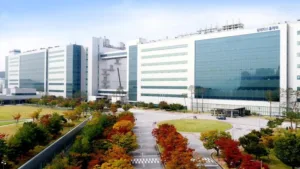Samsung Display announced its environmental strategy to become carbon neutral by 2050. To this end, the company recently joined RE100, a global initiative to promote the use of 100% renewable electricity. Samsung Display aims to use 100% renewable electricity at all its domestic and foreign business sites with the goal of achieving net zero emissions by 2050.
As part of its fight against climate change, Samsung Display is going to leverage continuous R&D and cooperation with global material companies to develop differentiated low-power displays, such as ECO² (ECO Square) OLED™, a technology that increases panel brightness by internalizing polarizing plate functions and reduces power consumption by 25% to 52%.
To protect irreplaceable resources, such as sand and water, Samsung Display will promote process material recycling and resource-circulated material development, and expand the circular economy ecosystem, an eco-friendly economic model that pursues sustainability through resource-saving and recycling.
Samsung Display plans to continue pursuing its environmental strategy through 2040 by recycling resources, reducing water waste, and developing eco-friendly materials.
“We are facing serious climate issues that require aggressive action. That’s why environmental strategy must become one of our highest priorities,” said JS Choi, CEO of Samsung Display. “Samsung Display will actively address this climate crisis — humanity’s biggest challenge — by continuing to reduce our carbon emissions, establishing a circular economy ecosystem in the display industry, and developing low-power eco-friendly technologies.”
Reducing process gas, developing alternative gas, and promoting the use of renewable energy to achieve carbon neutrality by 2050
Samsung Display plans to achieve carbon neutrality by 2050 by reducing both direct (Scope 1) and indirect (Scope 2) carbon emissions. To achieve that objective, the company will invest in infrastructures that minimize carbon directly emitted during its display production process by reducing power, process gas and fuel use; expanding process gas reduction facilities; and developing low GWP (Global Warming Index) alternative gas, etc.
To reduce indirect carbon emissions from electricity use, Samsung Display joined the RE100 in September and announced that renewable energy power will be gradually introduced to its businesses around the world through 2050.
Samsung Display already completed the conversion of its Chinese production sites to renewable energy in 2020 and plans to promote the use of renewable energy in all overseas production sites, including those in Vietnam and India, by the end of this year.
In addition, the company plans to increase the proportion of eco-friendly company vehicles every year by participating in the 2030 Pollution-Free Vehicle Conversion 100, which aims to convert business fleets to electric or hydrogen vehicles by 2030.
While improving the efficiency of organic materials through cooperation with global parts suppliers, Samsung Display plans to continuously reduce greenhouse gas emissions from the production of consumer products through the development of low-power and eco-friendly technologies, such as ECO² OLED™ in 2021 and ECO² OLED Plus™ in 2022.
Expanding the circular economy ecosystem and pursuing sustainable use of irreplaceable resources, such as sand and water
Samsung Display is expanding its efforts to establish a circular economy ecosystem in the display industry by minimizing the waste of resources, designing production processes with resource recycling in mind and developing recyclable resources.
To prepare for the global sand depletion crisis, Samsung Display continues to cooperate with companies in other fields and it plans to expand the circular economy ecosystem by recycling glass for substrates and carrier glass (glass for panel attachment used in the flexible OLED manufacturing process) as construction material and glass fiber raw material (used for ship structure and automobile interior materials).
In addition, Samsung Display developed a common plastic container that can be reused for panel transportation regardless of the model. This could replace the specific model containers that are usually discarded after use. The company is looking to expand its use of these reusable containers and may replace it with more eco-friendly materials in the future.
Due to the display industry’s massive water use, Samsung Display is expanding its investment to protect water resources. The company plans to actively enforce water responsibility as part of its 3R (Reduce, Reuse, Recycle) activities, and reduce water use annually. It plans to improve its manufacturing processes and utility infrastructure and increase its investment in advanced water treatment facilities to maximize water reuse.
To achieve carbon neutrality, Samsung Display created a Carbon Neutral Task Force division to establish and implement specific roadmaps for each task. Also, through its Sustainability Council, Samsung Display plans to track the progress of various environmental management initiatives.

